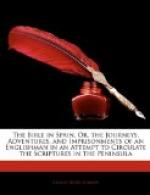Seville contains ninety thousand inhabitants, and is situated on the eastern bank of the Guadalquivir, about eighteen leagues from its mouth; it is surrounded with high Moorish walls, in a good state of preservation, and built of such durable materials that it is probable they will for many centuries still bid defiance to the encroachments of time. The most remarkable edifices are the cathedral and Alcazar, or palace of the Moorish kings; the tower of the former, called La Giralda, belongs to the period of the Moors, and formed part of the grand mosque of Seville: it is computed to be one hundred ells in height, and is ascended not by stairs or ladders but by a vaulted pathway, in the manner of an inclined plane: this path is by no means steep, so that a cavalier might ride up to the top, a feat which Ferdinand the Seventh is said to have accomplished. The view from the summit is very extensive, and on a fine clear day the mountain ridge, called the Sierra de Ronda, may be discovered, though upwards of twenty leagues distant. The cathedral itself is a noble Gothic structure, reputed the finest of the kind in Spain. In the chapels allotted to the various saints are some of the most magnificent paintings which Spanish art has produced; indeed the Cathedral of Seville is at the present time far more rich in splendid paintings than at any former period; possessing many very recently removed from some of the suppressed convents, particularly from the Capuchin and San Francisco.
No one should visit Seville without paying particular attention to the Alcazar, that splendid specimen of Moorish architecture. It contains many magnificent halls, particularly that of the ambassadors, so called, which is in every respect more magnificent than the one of the same name within the Alhambra of Granada. This palace was a favourite residence of Peter the Cruel, who carefully repaired it without altering its Moorish character and appearance. It probably remains in much the same state as at the time of his death.




